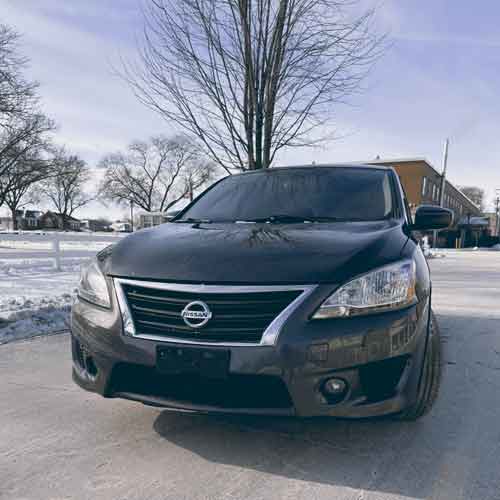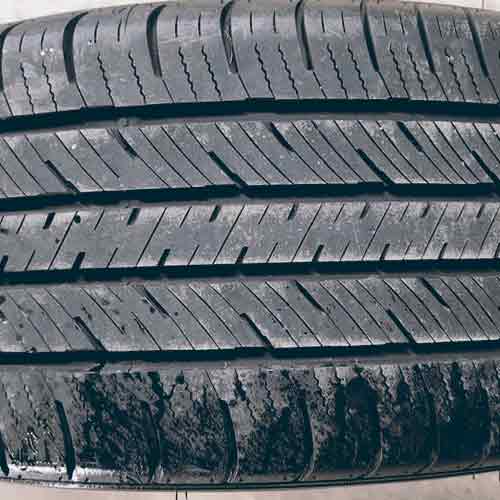Falken Sincera SN250 A/S is a great Standard Touring All-Season tire which performs reliably in many areas. Let’s explore this tire in greater details.

Table of Contents
Available Tire Sizes
The Falken Sincera SN250 A/S comes in 14 to 18 inches rims (63 total sizes). And these sizes have following specs.
- Speed ratings: T, H, and V.
- Load ratings: SL and XL.
- Tread depth: 11/32″ on all.
- Weight: 16 to 30 lbs.
- UTQG: 720 A A and 720 A B.
- Treadwear warranty: 80k miles on all sizes
- Internal Construction: SN250 A/S features 2 ply polyester casing, with two high-tensile steel belts and a polyamide reinforcement cap ply.
Tread Design
The Falken Sincera SN250 A/S features an elegantly symmetrical tread design, highlighted by five distinct ribs or block columns.

In the middle are three prominent ribs (block columns) characterized by their straightforward, linear formation.
The most central rib stands out with sharply angled notches and linear siping, strategically oriented in both lateral directions to enhance grip.
While neighboring ribs showcase slightly curved lateral grooves with offset edges and sipes.
These ribs are marginally wider, though maintaining a similar, continuous-running and unbroken design.
Same goes for shoulder ribs too, which are the widest.
And because of their continuous running designs, the lateral voids they have at the very edges act as in-groove notches, providing this tire with decent lateral bite particularly in dry scenarios.
Plus with the sipes which differ in design, exhibiting more aggressive (wave-like structures), you also get decent wet traction too.
Dry Performance
The performance of a tire in dry conditions can be analyzed through two main metrics: handling and directional grip.
Handling focuses on the tire’s lateral traction and steering responsiveness, while directional grip evaluates the tire’s adherence during straight-line movements. Let’s delve into each of these critical performance indicators.
Longitudinal Grip
Longitudinal grip is actually the tire’s ability to maintain traction with the road while moving forward, or you can say, in a straight line.
This grip is primarily measured by the tire’s braking efficacy, which is significantly influenced by the tire’s central region. This area bears the brunt of the vehicle’s weight when it moves straight, affecting stopping capabilities.
Now in this performance area, the Falken Sincera SN250 A/S performs very competently I have to say.
Its design features compact central ribs with longitudinally aligned lugs, optimized for smooth straight-line travel. These lugs, combined with multiple grooves and notches, offer commendable directional grip, as evidenced by the tire’s effective stopping power.
However, the tire’s somewhat heavy design introduces substantial rolling inertia, necessitating more energy, and consequently more time, to halt (notably from 60 mph based on tests).
Though, a side, note, it outperformed the new grand touring Cooper ProControl, stopping 1.5 feet shorter on average in braking tests, which was very interesting to note.
Lateral Grip and Handling
When it comes to lateral grip and handling, the tire’s performance is slightly lacking, especially when compared to its chief competitor.
And across all sizes, the Sincera SN250 A/S provides approximately 0.7 G lateral traction, resulting in lap times that are just average.
I mean the tire’s performance here could have been better.
The primary reason for this discrepancy lies in the tire’s steering characteristics.
The steering response is notably subdued at the center, demanding more input than typical to initiate a direction change.
Once the tire does react, it tends to oversteer, complicating vehicle handling and requiring precise throttle control to manage the tire’s response effectively. This aspect of performance clearly indicates areas where enhancements could markedly improve handling and overall driving experience.
Wet Performance
Evaluating tire performance on wet surfaces hinges on two critical factors: wet traction and hydroplaning resistance.
Let’s start with grip and handling part.
Wet Grip and Handling
Now the Falken Sincera SN250 A/S achieves a commendable balance in wet conditions.
While it may not boast the fastest lap times or the shortest braking distances, its overall performance is reliably balanced. The steering is precise, braking consistent, and the tire maintains grip through sharp corners, though pushing it too far can lead to oversteering, which it recovers from smoothly.
The key to superior wet grip lies in extensive siping and significant tread flexibility.
Those of you who don’t know sipes are tiny channels that work on a microscopic level to effectively displace water by trapping and then expelling water particles as they compress between the road and the tread.
And the Falken Sincera SN250 A/S performs reasonably well in these areas, offering 10 feet shorter braking distances in wet conditions from 50 to 0 mph compared to the General Altimax RT45 (another great tire in its category).
But yes the Falken’s tire could improve its steering response here as well. I mean there is a small delay, which puts the tire with a tendency to oversteer.
And this is because of the tire’s weight and less flexible tread.
A heavier structure generates more momentum, leading to potential oversteering, while stiffer rubber reduce the tire’s ability of rubber/grooves to absorb and expel water, increasing the likelihood of slippage.
But keep in mind this only happens when you push tire to its limits.
Hydroplaning
Hydroplaning is a critical safety concern, occurring when a tire rides on a water surface instead of the road, due to a layer of water that prevents direct contact with the pavement. Tires combat this with specially designed grooves that channel water away efficiently, though primarily in a straight line rather than laterally.
Now the Falken Sincera SN250 A/S is designed with four symmetrically aligned channels that adeptly remove water from beneath the tread, aiding in maintaining stability at higher straight-line speeds before hydroplaning occurs.
However, the tire’s design falls short in effectively connecting these channels laterally, which diminishes its performance in curved hydroplaning scenarios.
The absence of robust lateral water expulsion paths limits its ability to maintain grip and stability when cornering on wet surfaces, underscoring areas for potential improvement in water management and safety features.
Snow and Ice Performance
The Falken Sincera SN250 A/S displays notable challenges in winter conditions, particularly because it lacks the 3 Peak Mountain Snowflake certification—a standard for its category in grand touring all-season tires.
The primary issue lies in its directional traction, crucial for assessing snow acceleration and braking capabilities. This shortfall is mainly due to an insufficient number of biters in the central tread region.
Although the tire includes a fair amount of biting edges on its shoulders, its performance in winter conditions is hampered by the stiffness of its rubber compound. This rigidity limits the functionality of the biters.
t temperatures typically below 45 degrees Fahrenheit, the rubber becomes too hard, diminishing the effectiveness of these biters.
Flexibility in the biters is vital as it allows the tire to clasp snow particles, facilitating snow-to-snow contact that creates more friction than snow-to-rubber contact. Snow adheres better to itself than to rubber.
Hence, the lack of flexibility means the tire cannot accumulate sufficient snow, leading to diminished traction, especially on ice.
Ride Quality
Evaluating ride quality involves considering a tire’s capacity to mitigate road vibrations and reduce noise, enhancing the overall driving comfort. Let’s explore how the Falken Sincera SN250 A/S manages these critical elements.
Noise Comfort
The Falken Sincera SN250 A/S is not entirely silent, but it effectively minimizes prominent cyclical or pattern noise, which mostly recedes into the background. Noise generation in tires often results from air striking the tread and interacting with features like sipes, producing various tones, including some growling sounds.
While these noises are generally mild to low in volume, they can be accentuated by echoes within the tire’s grooves, a phenomenon known as in-groove resonance.
However, the Falken Sincera SN250 A/S largely counteracts these noises with its variable pitch pattern, which segments and disperses sound into different frequencies that attempt to cancel each other out. The composition of the tread also plays a role by absorbing sound waves, thereby dampening in-groove resonance.
Despite these noise-reducing qualities, the same polymer additives that enhance noise control also contribute to the tire’s rigidity.
Consequently, while the tire performs well in reducing noise on the road, it is less effective in absorbing vibrations and smoothing out bumps, which affects its overall comfort rating.
Ride Smoothness
Ride smoothness is essentially about how effectively a tire can absorb road imperfections. The Falken Sincera SN250 A/S performs competently in this area. It offers a well-damped ride on uneven surfaces and maintains tranquility on smoother roads.
However, its performance on larger bumps is less impressive, as it reaches its comfort limit more quickly.
This limitation is largely due to its stiffer shoulders and sidewalls, which are less effective at settling bumps smoothly, resulting in more pronounced vertical movement after encountering road irregularities.
Despite this, the tire does provide decent stability, especially when compared to other contenders in the standard touring all-season category.
Fuel Economy
Fuel efficiency in tires is intricately linked to their rolling resistance, which is significantly influenced by the tire’s weight. The Falken Sincera SN250 A/S has room for improvement in this regard.
Technically, the weight concentration on the lugs makes them prone to bending. The tire incorporates a 2-ply polyester casing, bringing its weight to approximately 30 lbs for 18-inch wheels.
This additional mass puts more pressure on the lugs, causing them to flex. This flexing and subsequent return to their original shape result in energy loss, which adversely affects the tire’s overall fuel efficiency.
Wrapping Up
In conclusion, the Falken Sincera SN250 A/S demonstrates varied performance across different conditions.
In dry settings, it offers effective handling and decent directional grip but struggles with lateral traction compared to competitors.
Its wet performance is commendable, maintaining good grip and handling despite some hydroplaning challenges due to inadequate lateral water evacuation. In snowy and icy conditions, the tire’s performance is hindered by its lack of flexibility and insufficient biters, affecting its traction capabilities.
Ride quality is generally smooth on less challenging surfaces, but the tire’s rigidity impacts comfort on larger bumps and reduces its effectiveness in vibration absorption.
And lastly, the tire’s fuel efficiency is compromised by its heavier design, which increases rolling resistance and energy loss.